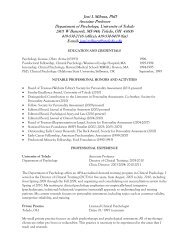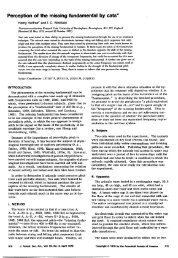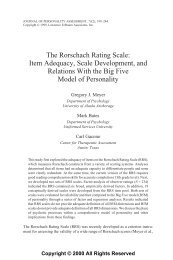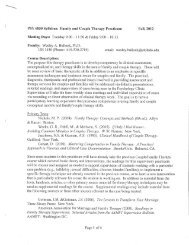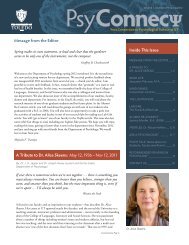1 RPAS Administration Guidelines to Optimize R This ... - Psychology
1 RPAS Administration Guidelines to Optimize R This ... - Psychology
1 RPAS Administration Guidelines to Optimize R This ... - Psychology
You also want an ePaper? Increase the reach of your titles
YUMPU automatically turns print PDFs into web optimized ePapers that Google loves.
when they are low (e.g., resistance or limited resources) and high (e.g., fluid, affectively driven<br />
responding).<br />
4) Fourth, <strong>to</strong> help ensure a sufficient pool of responses for interpretation, if you do not obtain 14 or<br />
more responses initially, retain all the initial responses but go through all cards again with<br />
encouragement for the respondent <strong>to</strong> give a few more responses. Unlike standard CS<br />
administration, use the responses from the first administration but administer the cards again and<br />
collect the extra responses that are spontaneously given. Once this is done, complete the inquiry<br />
based on the order of the responses within a card, not the order in which the responses were<br />
obtained. Although it is quite unlikely <strong>to</strong> occur, if the respondent produces fewer than 16<br />
responses say something like:<br />
a. "That was fine. However, we need a few more responses in order for this test <strong>to</strong> be most<br />
helpful. So let's go through the cards again. Take your time when looking at them. I'm<br />
sure you will be able <strong>to</strong> see some more things." Hand the respondent, the first card and<br />
say, "What else might this be?" Say this only once. During this second administration no<br />
prompts or pulls are given. Rejections are accepted. Although this approach complicates<br />
how a sequence analysis interpretation would be conducted, it reduces demands on the<br />
examinee compared <strong>to</strong> redoing the whole test and this is likely <strong>to</strong> preserve the alliance<br />
and reduce the added frustration or discouragement that could affect their scores on a<br />
second administration.<br />
When it is time <strong>to</strong> administer the Rorschach, say the following, "Now we are going <strong>to</strong> take the inkblot<br />
test. I will hand the inkblots <strong>to</strong> you one at a time and your task is <strong>to</strong> look at each card <strong>to</strong> answer the<br />
question "What might this be?" Does that make sense?" If the answer is no, find out what is unclear and<br />
address the issue. If the answer is yes, say the following: "Good. We can get started then. Try <strong>to</strong> give<br />
two responses, or maybe three, <strong>to</strong> each card. That is, for each card try <strong>to</strong> see two, or maybe three,<br />
different things." Next, hand Card I in the upright position <strong>to</strong> the respondent and say just the following<br />
four words: "What might this be?"<br />
Use clinical judgment <strong>to</strong> balance the need for consistent administration guidelines and the need for<br />
personal rapport and a good working alliance with the respondent. For instance, although we note that it<br />
may make sense <strong>to</strong> inquire one or several responses that happen <strong>to</strong> come after the fourth, if a respondent<br />
consistently gives extra responses, it may be most reasonable <strong>to</strong> explain at the start of the inquiry that<br />
you will only be asking about the first four <strong>to</strong> each card.<br />
Research on an early version of the "Prompt for Two, Pull after Four" guideline showed that it<br />
eliminated the need <strong>to</strong> re-administer the test because of short pro<strong>to</strong>cols and it increased the validity of<br />
Rorschach measures of thought disorder and psychosis (Dean, Viglione, Perry, & Meyer, 2007).<br />
© 2010 <strong>RPAS</strong> 2



